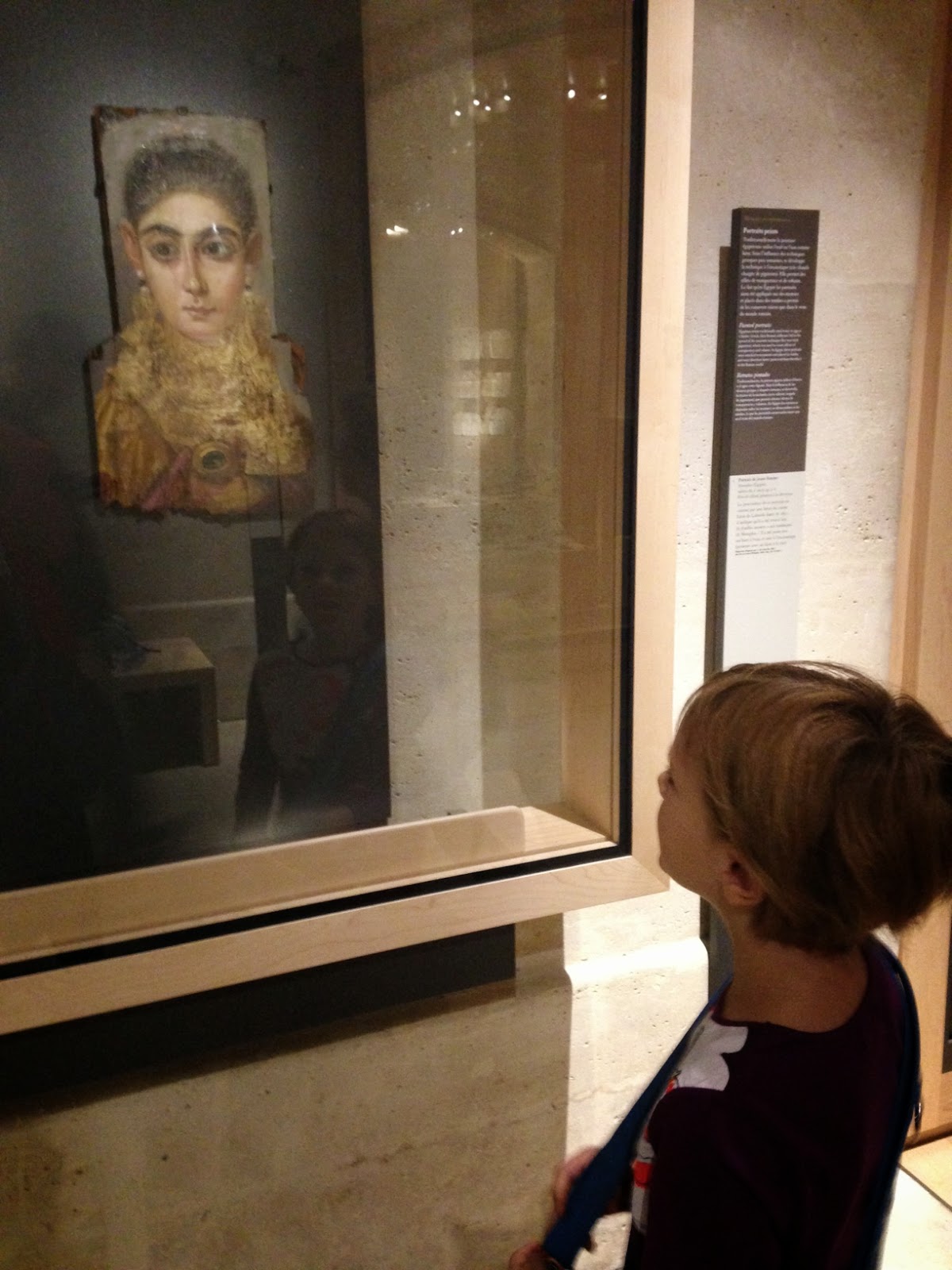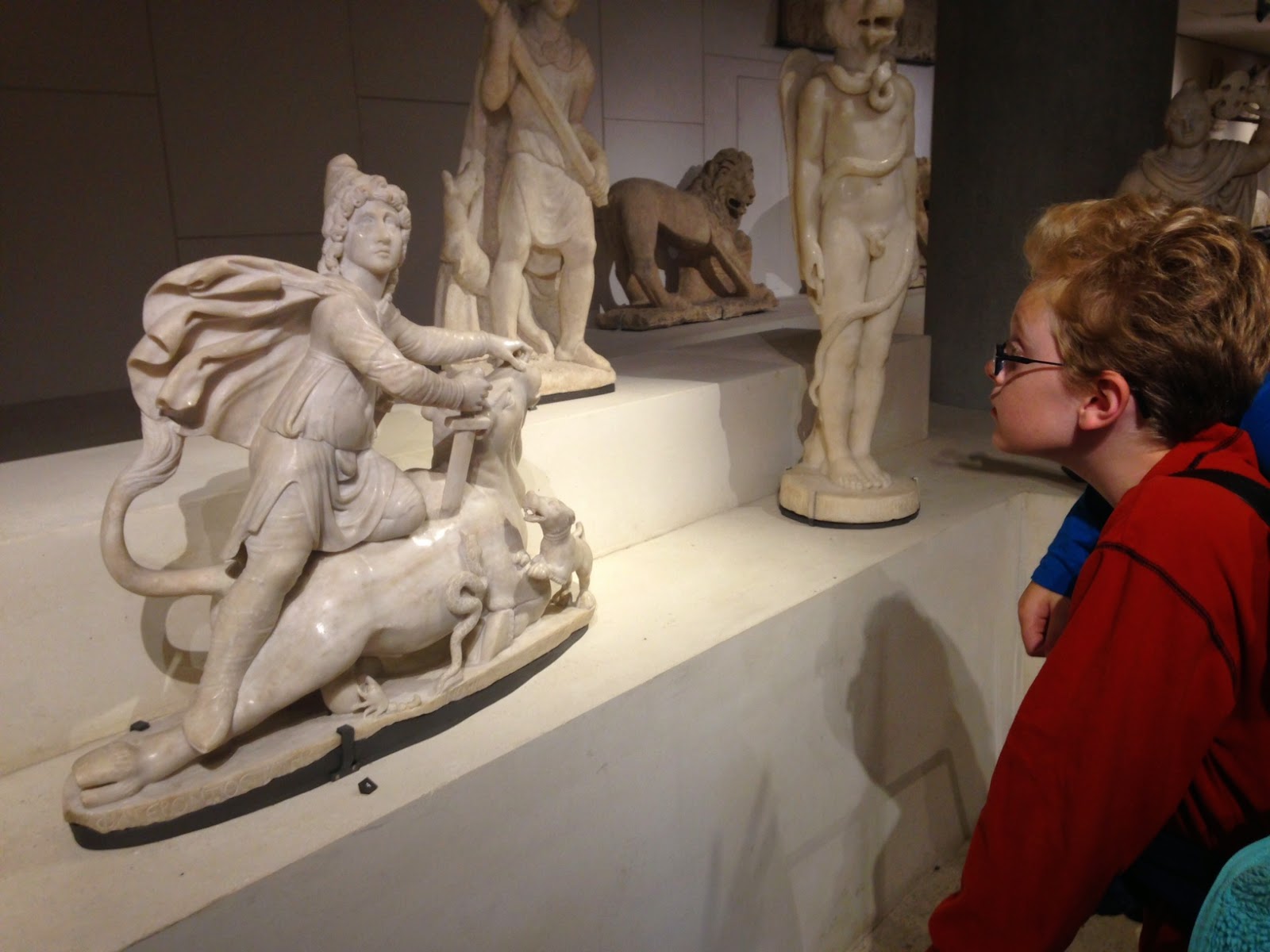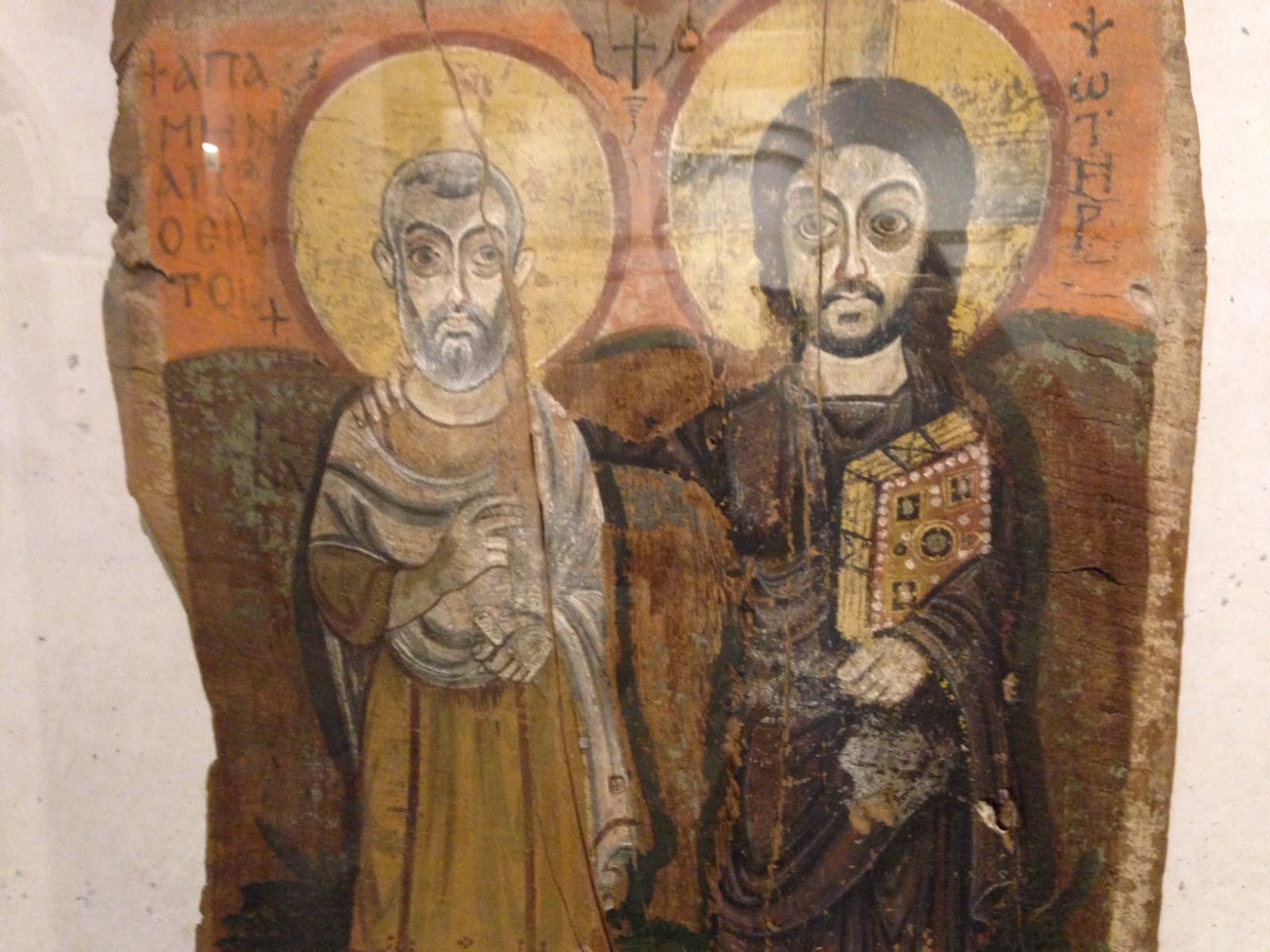Medieval History
 Lasting presence abounds in the descriptively dubbed East Mediterranean of the Roman Empire galleries. The Fayum portraits are their emblem and immediately place you in this end-of-an-era hybridity - it's the end of the Roman Empire as you know it, and at least some people are feeling fine. The Fayum portraits are this incredible encaustic decision to paint portraits of the diseased for their mummy casings. There are still masks (gold-painted not gold itself anymore, terra cotta or painted fired clay mostly) but it's the Fayum portraits that have seized the imagination in their lifelikeness, in the memory of their subjects seeming so fresh.
Lasting presence abounds in the descriptively dubbed East Mediterranean of the Roman Empire galleries. The Fayum portraits are their emblem and immediately place you in this end-of-an-era hybridity - it's the end of the Roman Empire as you know it, and at least some people are feeling fine. The Fayum portraits are this incredible encaustic decision to paint portraits of the diseased for their mummy casings. There are still masks (gold-painted not gold itself anymore, terra cotta or painted fired clay mostly) but it's the Fayum portraits that have seized the imagination in their lifelikeness, in the memory of their subjects seeming so fresh.
 I had invited the kids to find a "Fayum friend," a person whose portrait would make you want to be friends with them. This was initially critiqued by Iris, who pointed out that judging the possibility of friendship by how someone looks is superficial. She's right, of course, and so made me think more about what I was going for. What is it about any one particular portrait that reaches out to a viewer? That "speaks" to us and makes us want to know more about that person? And why do the Fayum portraits do it so incredibly well? It's not just shadows and gleaming eyes and the curve of cheeks - there's something else that makes a viewer stop and connect and I don't know what it is. Once I was able to convince Iris that this was about what made her as a viewer curious (as opposed to her as a potential friend accepting), then we were good to go. Here is Eleanor with her Fayum friend, the mystery of the connection palpable.
I had invited the kids to find a "Fayum friend," a person whose portrait would make you want to be friends with them. This was initially critiqued by Iris, who pointed out that judging the possibility of friendship by how someone looks is superficial. She's right, of course, and so made me think more about what I was going for. What is it about any one particular portrait that reaches out to a viewer? That "speaks" to us and makes us want to know more about that person? And why do the Fayum portraits do it so incredibly well? It's not just shadows and gleaming eyes and the curve of cheeks - there's something else that makes a viewer stop and connect and I don't know what it is. Once I was able to convince Iris that this was about what made her as a viewer curious (as opposed to her as a potential friend accepting), then we were good to go. Here is Eleanor with her Fayum friend, the mystery of the connection palpable.
 The mystery is what remains (for me, for others, but there are experts who can explain the details) when it comes to the Mithraic cult, a mystery cult concurrent with that other, better known mystery cult, Christianity. Mystery here means underground both literally and figuratively, and also the suspicion that maybe the rituals mean more than just their act. Mithra, Persian god, is a reminder of how big and permeable the Roman empire is from the 1st to the 4th centuries C.E.. So much so that a zodiac (there's Aquarius, Pisces, Cancer) all around the sacrifice of the bull - that valiant diagonal, that murderous thrust.
The mystery is what remains (for me, for others, but there are experts who can explain the details) when it comes to the Mithraic cult, a mystery cult concurrent with that other, better known mystery cult, Christianity. Mystery here means underground both literally and figuratively, and also the suspicion that maybe the rituals mean more than just their act. Mithra, Persian god, is a reminder of how big and permeable the Roman empire is from the 1st to the 4th centuries C.E.. So much so that a zodiac (there's Aquarius, Pisces, Cancer) all around the sacrifice of the bull - that valiant diagonal, that murderous thrust.
 Oliver was beside himself with excitement - so was I. Teaching the Mithraic materials at San Clemente in Rome (with the great teaching text by Jas Elsner) is one of my favorite moments in the survey class, and I still daydream about a "Rome 400" class (whenever the world started to go upside down for the Roman Empire and so many things were possible). Oliver loves it when I do, and we'd visited the Mithraic temple beneath San Clemente (worlds upon worlds). To find this many statues devoted to Mithra all so beautiful and complete and all positioned together like that was incredible. It was utterly unexpected and yet there they were one after another, strange creatures bedecked by their mysterious symbols, gathered in some still potent assembly.
Oliver was beside himself with excitement - so was I. Teaching the Mithraic materials at San Clemente in Rome (with the great teaching text by Jas Elsner) is one of my favorite moments in the survey class, and I still daydream about a "Rome 400" class (whenever the world started to go upside down for the Roman Empire and so many things were possible). Oliver loves it when I do, and we'd visited the Mithraic temple beneath San Clemente (worlds upon worlds). To find this many statues devoted to Mithra all so beautiful and complete and all positioned together like that was incredible. It was utterly unexpected and yet there they were one after another, strange creatures bedecked by their mysterious symbols, gathered in some still potent assembly.
 This is a terrible photograph of a beloved icon - I've never taught it, but now I have a frame of mind for it. You find the icon, and an entire recreated room of the site of Bawit monastery where it was excavated by (the Frenchman) Jean Clédat in 1901-5. You find all this (and it's all incredible: there are shoes and chasubles, doorways of wood and stone, wall paintings, and this marvelous marvelous icon, from the 8th century, possibly the oldest Coptic icon remaining) if you just keep walking through the end-of-the-Roman-Empire galleries. Isn't that smart? It wasn't a seamless transition, of course, from the Roman Empire to the period marked by an emerging Christianity (Christian cultures, really, there were so many), and the trajectory of the rooms takes you from one time to another and actually makes room for departures from the transition, like the Mithraic material. The Coptic trajectory is brief (curtailed by the advent of Islam in Egypt in the 8th-10th centuries), more of an offshoot than an arrival, and yet the layout of the galleries is such that it comprises the final rooms of that section of the museum. Smart. Gives you pause. In this sense, the Louvre layout is more about departures and ruptures than about continuity and transition - which I like. The monastery of Bawit itself was founded in the late 4th century and continued to thrive until the 8th century. By the 10th century it was abandoned, stilled until its intersection with the mission that Clédat had been given to find Christian sites in Muslim lands (and oh my yes, there's a tale to be told there, and yes, it ultimately involves the Suez Canal). Somewhere in the monastery site (and Clédat's notes don't reveal where), this icon of Christ with his arm around Abbot Mena was found. I immediately think of Peter Brown's "friend," of Christ as companion (and oh my goodness, doesn't Brown's new book look amazing???). The stillness of this piece has always fascinated me, made me think about all sorts of stillnesses, because in this stillness is a kind of intimacy. Christ emerges (yes, seamlessly) in the 8th century to put his arm around Abbot Mena, this older man, this reigning caregiver of the monastery. Why was the portrait made? One thinks of the 8th century as a time of change, at Bewit marking the beginning of the monastery's decline, throughout Egypt as a time energized by the advent and appeal of Islam. Stillness here does not mean eternity. In that sense, this icon is very unlike the concept of icons and their transcendental stillness and eternity. In that sense, this icon is wonderfully poignant. Its stillness (I love to think about this so much I'm going to write it again) offering an image of intimacy. The painting is small (57cm x 57 cm) - you could hold it in your hands (oh!). It's painted on sycamore fig wood, a material of physical, Biblical, and even parabolic (!) availability. Was it simply part of a much greater arrangement of figures? An iconostasis? Or was it already isolated in this intimacy? The gesture of Christ marking a space around the Abbot Mena and that which, in the cliffs overlooking the Nile where his monastery lay, he held dear?
This is a terrible photograph of a beloved icon - I've never taught it, but now I have a frame of mind for it. You find the icon, and an entire recreated room of the site of Bawit monastery where it was excavated by (the Frenchman) Jean Clédat in 1901-5. You find all this (and it's all incredible: there are shoes and chasubles, doorways of wood and stone, wall paintings, and this marvelous marvelous icon, from the 8th century, possibly the oldest Coptic icon remaining) if you just keep walking through the end-of-the-Roman-Empire galleries. Isn't that smart? It wasn't a seamless transition, of course, from the Roman Empire to the period marked by an emerging Christianity (Christian cultures, really, there were so many), and the trajectory of the rooms takes you from one time to another and actually makes room for departures from the transition, like the Mithraic material. The Coptic trajectory is brief (curtailed by the advent of Islam in Egypt in the 8th-10th centuries), more of an offshoot than an arrival, and yet the layout of the galleries is such that it comprises the final rooms of that section of the museum. Smart. Gives you pause. In this sense, the Louvre layout is more about departures and ruptures than about continuity and transition - which I like. The monastery of Bawit itself was founded in the late 4th century and continued to thrive until the 8th century. By the 10th century it was abandoned, stilled until its intersection with the mission that Clédat had been given to find Christian sites in Muslim lands (and oh my yes, there's a tale to be told there, and yes, it ultimately involves the Suez Canal). Somewhere in the monastery site (and Clédat's notes don't reveal where), this icon of Christ with his arm around Abbot Mena was found. I immediately think of Peter Brown's "friend," of Christ as companion (and oh my goodness, doesn't Brown's new book look amazing???). The stillness of this piece has always fascinated me, made me think about all sorts of stillnesses, because in this stillness is a kind of intimacy. Christ emerges (yes, seamlessly) in the 8th century to put his arm around Abbot Mena, this older man, this reigning caregiver of the monastery. Why was the portrait made? One thinks of the 8th century as a time of change, at Bewit marking the beginning of the monastery's decline, throughout Egypt as a time energized by the advent and appeal of Islam. Stillness here does not mean eternity. In that sense, this icon is very unlike the concept of icons and their transcendental stillness and eternity. In that sense, this icon is wonderfully poignant. Its stillness (I love to think about this so much I'm going to write it again) offering an image of intimacy. The painting is small (57cm x 57 cm) - you could hold it in your hands (oh!). It's painted on sycamore fig wood, a material of physical, Biblical, and even parabolic (!) availability. Was it simply part of a much greater arrangement of figures? An iconostasis? Or was it already isolated in this intimacy? The gesture of Christ marking a space around the Abbot Mena and that which, in the cliffs overlooking the Nile where his monastery lay, he held dear?
- New Facial Recognition Software To Help Solve Art Mysteries
Anyone who has admired centuries-old sculptures and portraits displayed in museums and galleries around the world at some point has asked one question: Who is that? Three University of California, Riverside scholars have launched a research project to...
- Decline And Fall: New Book Examines How The Western Roman Empire Collapse
The Fall of the Western Roman Empire: An Archaeological and Historical Perspective is the latest book from Dr Neil Christie of the University of Leicester. The division of the vast Roman Empire can be traced chiefly to the 280s AD when the Empire, wracked...
- Ethiopian Christ Icon Found 500 Years On
An 15th century Ethiopian icon of the infant Christ child sitting on his mother's knee was discovered after it was cleaned by a British charity. The central panel of the triptych had over the centuries become blackened with the sprinkling of perfume...
- Edges Of Empire
Ruins of port at Acre (AkkoAre the edges of empire the weakest or most promising places to be? Are they where is manifested the greatest distortion of the center, or its greatest ambition and innovation? I like this taunt, stretching place,...
- Interviews, Part Iii
My good friend Mollie Craig has kindly responded to the interview questions, posted below. I bet you didn't know there were Romanian medieval churches with exterior frescoes, did you? Mollie approaches Art History with an open mind and always has...
Medieval History
Fayum Friend
- New Facial Recognition Software To Help Solve Art Mysteries
Anyone who has admired centuries-old sculptures and portraits displayed in museums and galleries around the world at some point has asked one question: Who is that? Three University of California, Riverside scholars have launched a research project to...
- Decline And Fall: New Book Examines How The Western Roman Empire Collapse
The Fall of the Western Roman Empire: An Archaeological and Historical Perspective is the latest book from Dr Neil Christie of the University of Leicester. The division of the vast Roman Empire can be traced chiefly to the 280s AD when the Empire, wracked...
- Ethiopian Christ Icon Found 500 Years On
An 15th century Ethiopian icon of the infant Christ child sitting on his mother's knee was discovered after it was cleaned by a British charity. The central panel of the triptych had over the centuries become blackened with the sprinkling of perfume...
- Edges Of Empire
Ruins of port at Acre (AkkoAre the edges of empire the weakest or most promising places to be? Are they where is manifested the greatest distortion of the center, or its greatest ambition and innovation? I like this taunt, stretching place,...
- Interviews, Part Iii
My good friend Mollie Craig has kindly responded to the interview questions, posted below. I bet you didn't know there were Romanian medieval churches with exterior frescoes, did you? Mollie approaches Art History with an open mind and always has...
